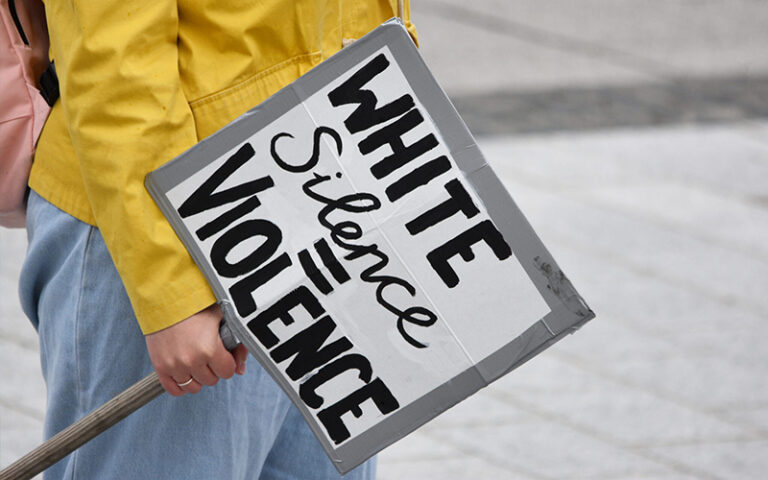The atrocity that occurred in Buffalo this past weekend is the latest horrific installment in this country’s war on Black people, a war that has been raging for centuries. Little good comes from describing the violence or declaring our shock here: those have been expressed in countless speeches, podcasts, exposés, poems, and more.
For Black people, this is another day in America. Another day of grief. Another day of fatigued anger. Another day of insecurity and danger. For Black people, there is little choice and no protection from this constant onslaught of violence that can happen anywhere, at any time.
White people, on the other hand, have safety and choice. So for white people, this is another day to choose between desensitized apathy and action on behalf of fellow Black humans with targets on their backs. Another day to choose how we talk about racism and how we banish racists from our dinner tables, communities, and board rooms.
But remember this: There is no neutral ground.
We have the choice to start a revolution, and we have the responsibility. White supremacy will not end until white people act collectively to end it.
Below are actions white educators can take today to stand against racism. They are framed through CT3’s pillars of Anti-Racism: Use Direct Language, Honor Students of Color First, and Speak Truth to Power.
Use Direct Language
- Choose to break the silence. Talk candidly with white youth about ongoing racial violence using factually accurate, direct language. Don’t shy away from terms such as white supremacy, racism, mass shootings, anti-Black violence, digital misinformation, radicalization, and white extremism. Draw from readily available, developmentally appropriate resources when speaking with youth. White silence is violence.
- Acknowledge that what happened in Buffalo is not an isolated event. It exists within, and was commissioned by, a culture of anti-Black hatred.
- Unpack how white supremacy, including white saviorism, shapes your views of education and your role as an educator. Critically analyze ways your school system perpetuates oppression, and dismantle where necessary.
- Stand for educating white youth about Black history, providing accurate historical and contemporary context and exploring missing and stolen history.
- Speak out against policies and white supremacist rhetoric that falsely claim to protect white children from America’s heinous racist history.
- Highlight examples of Black resilience, joy, excellence, and healing amid racial trauma.
- Find committed, capable people working to overcome white supremacy, and if using direct language feels daunting, seek opportunities to practice using it. Organizations such as Education for Racial Equity offer spaces for white bodies to unite in efforts to end racism.
Honor Students of Color First
- Triage your recovery efforts, as this is a fight for students’ lives. Just as the effects of a natural disaster are not equally distributed, this monstrous disaster lands most heavily on Black students and their families.
- Utilize pre-recorded statements from Black youth to amplify their voices and teach about racial equity without requiring emotional labor.
- Honor Black students’ voices in classroom dialogue about their racialized experiences, but above all else, allow them to contribute on their terms.
- Support local schools with resources for Black children’s emotional well-being amid anti-Black racism.
- Center the experiences of victims and the affected community, not the perpetrator. Do not waste time on examining, explaining, or justifying the motives or actions of the murderer. Instead, emphasize that progress comes from understanding the perspectives of oppressed communities and heeding their recommendations.
- Avoid causing harm and requiring emotional labor from Black youth, staff members, and families. Do not require Black individuals to explain their experiences. Give space and be willing to lighten their loads in ways that are meaningful to them.
- Create conditions for rest and healing and acknowledge that you likely cannot (directly) provide that healing.
Speak Truth to Power
- Create space for students, fellow staff members, and community members to grieve, process, and heal. But recovery from a single incident is not sufficient. Recovery is not the same as justice. As white educators, we can address the roots of white supremacy within the classroom.
- Take risks. Focus on engaging specific individuals in positions of power, from school board members to PTO presidents. Steer their power toward liberation.
- Speak truth to power at the ballot box, acknowledging the great influence wielded by down-ballot elections.
- Amplify Black voices in proposing, crafting, and implementing solutions. Because educators and policy makers are disproportionately white, there is plenty of room for error and saviorism. Defer to Black community leaders and learn from documented recommendations given by Black scholars and thought leaders.
- Recruit other white educators to maximize impact and avoid burning out.
- Consistently contact your government representatives. Take advantage of opportunities to talk with these representatives and their staff.
Opportunities for learning are widely available; now is the time to choose action. It is the time to ask yourself, what am I prepared to do?
by Leah Pearson and John Maynes
Check out CT3 Education programs such as No-Nonsense Nurturer, Real Time Teacher Coaching, and Real Time Leadership Coaching to find out more about Professional Development for Teachers and Leaders, classroom management strategies, and building relationships with students and their families, and properly addressing important issues in the classroom and school.
Category: Anti-Racism


